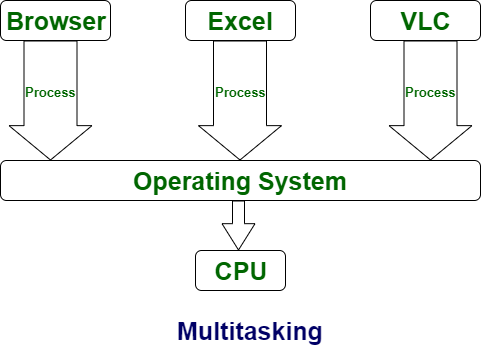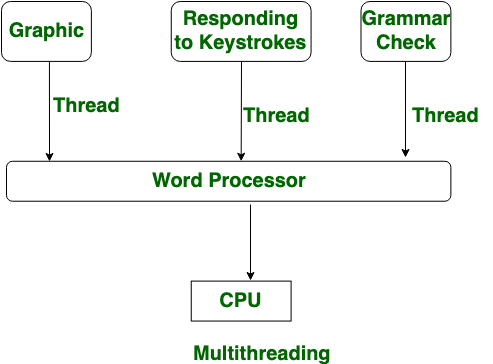Difference between Multi-tasking and Multi-threading
Last Updated :
03 May, 2023
Introduction :
Multi-tasking and multi-threading are two techniques used in operating systems to manage multiple processes and tasks.
Multi-tasking is the ability of an operating system to run multiple processes or tasks concurrently, sharing the same processor and other resources. In multi-tasking, the operating system divides the CPU time between multiple tasks, allowing them to execute simultaneously. Each task is assigned a time slice, or a portion of CPU time, during which it can execute its code. Multi-tasking is essential for increasing system efficiency, improving user productivity, and achieving optimal resource utilization.
Multi-threading is a technique in which an operating system divides a single process into multiple threads, each of which can execute concurrently. Threads share the same memory space and resources of the parent process, allowing them to communicate and synchronize data easily. Multi-threading is useful for improving application performance by allowing different parts of the application to execute simultaneously.
The main difference between multi-tasking and multi-threading is that multi-tasking involves running multiple independent processes or tasks, while multi-threading involves dividing a single process into multiple threads that can execute concurrently. Multi-tasking is used to manage multiple processes, while multi-threading is used to improve the performance of a single process.
Prerequisite – Multiprogramming, multitasking, multithreading and multiprocessing Multitasking: Multitasking is when a CPU is provided to execute multiple tasks at a time. Multitasking involves often CPU switching between the tasks, so that users can collaborate with each program together. Unlike multithreading, In multitasking, the processes share separate memory and resources. As multitasking involves CPU switching between the tasks rapidly, So the little time is needed in order to switch from the one user to next. 
Multithreading: Multithreading is a system in which many threads are created from a process through which the computer power is increased. In multithreading, CPU is provided in order to execute many threads from a process at a time, and in multithreading, process creation is performed according to cost. Unlike multitasking, multithreading provides the same memory and resources to the processes for execution. 
Let’s see the difference between multitasking and multithreading:
| S.NO |
Multitasking |
Multithreading |
| 1. |
In multitasking, users are allowed to perform many tasks by CPU. |
While in multithreading, many threads are created from a process through which computer power is increased. |
| 2. |
Multitasking involves often CPU switching between the tasks. |
While in multithreading also, CPU switching is often involved between the threads. |
| 3. |
In multitasking, the processes share separate memory. |
While in multithreading, processes are allocated the same memory. |
| 4. |
The multitasking component involves multiprocessing. |
While the multithreading component does not involve multiprocessing. |
| 5. |
In multitasking, the CPU is provided in order to execute many tasks at a time. |
While in multithreading also, a CPU is provided in order to execute many threads from a process at a time. |
| 6. |
In multitasking, processes don’t share the same resources, each process is allocated separate resources. |
While in multithreading, each process shares the same resources. |
| 7. |
Multitasking is slow compared to multithreading. |
While multithreading is faster. |
| 8. |
In multitasking, termination of a process takes more time. |
While in multithreading, termination of thread takes less time. |
| 9. |
Isolation and memory protection exist in multitasking. |
Isolation and memory protection does not exist in multithreading. |
| 10. |
It helps in developing efficient programs. |
It helps in developing efficient operating systems. |
| 11. |
Involves running multiple independent processes or tasks |
Involves dividing a single process into multiple threads that can execute concurrently
|
| 12. |
Multiple processes or tasks run simultaneously, sharing the same processor and resources |
Multiple threads within a single process share the same memory space and resources
|
| 13. |
Each process or task has its own memory space and resources |
Threads share the same memory space and resources of the parent process
|
| 14. |
Used to manage multiple processes and improve system efficiency |
Used to manage multiple processes and improve system efficiency |
| 15. |
Examples: running multiple applications on a computer, running multiple servers on a network |
Examples: splitting a video encoding task into multiple threads, implementing a responsive user interface in an application |
Like Article
Suggest improvement
Share your thoughts in the comments
Please Login to comment...